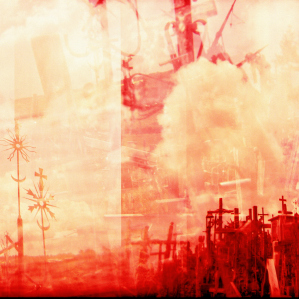July 11, 2009
 Last month’s journey throughout Lithuania was in part to begin work on what I hope will be a life-long project of artistic exploration of that country…so much for the ancestors deciding to emigrate. They spent all that effort sneaking out through sweat and tears and blood, and then it becomes a holiday destination (and source of inspiration) for the subsequent generation.
Last month’s journey throughout Lithuania was in part to begin work on what I hope will be a life-long project of artistic exploration of that country…so much for the ancestors deciding to emigrate. They spent all that effort sneaking out through sweat and tears and blood, and then it becomes a holiday destination (and source of inspiration) for the subsequent generation.
One of my Kryziu Kalnas (Hill of Prayers) photographs is at the Deborah Martin Gallery in downtown Los Angeles from 9 July – 9 August. It’s 2ft by 21ft, exhibited in 9 aluminum panels. The Catholics immediately see the face of the Virgin Mary, and the homeless men at the bus stop report seeing the Angel of Death.
www.deborahmartingallery.com
Created over a thousand years ago to contain the bodies, bones and amulets of ancient pagans, the burial mound of KRYZIU KALNAS (the Hill of Prayers) can be heard long before it can be seen, an eerie melody of sacred totems rattling in the fierce winds that sweep across the flat and silent marshlands of Lithuania.
In the 1100s, KRYZIU KALNAS then became a pagan Temple to the snake goddess, with Snake Goddess and Sun God symbols rising up into the sky on tall iron posts.
In the 1300s, the temple at KRYZIU KALNAS was fortified for war – one of the last strongholds of pagan resistance against the Christian crusaders.
In the 1500s, KRYZIU KALNAS fell into the hands of Catholic priests, who buried
their own dead on the site, attaching crosses and rosaries to the snake and sun poles.
During the next 500 years, war and occupation cause more bodies to fall here, and KRYZIU KALNAS became a place of protest, prayer and memorial as Lithuanians brought stones, totems and crosses to mark each brutal loss.
In the early1940s, when Lithuanian Nazis murdered the area’s Jews.
Again in the late1940s, when the Soviets claimed the territory from the Nazis.
And once more when Stalin sent thousands of villagers to their death in Siberian concentration camps.
In 1950, Stalin bulldozed KRYZIU KALNAS – destroying over 1,0000 years of graves. He annihilated the temple and fort ruins, burning the wood carvings, crushed the crosses for scrap metal, buried the entire site under six feet of raw sewage, and then enclosed it in razor wire.
The Soviets captured and executed anyone caught rebuilding the site, yet for 40 years, Lithuanians came in dark new-moon nights and built new suns and snakes and crosses.
This cycle of destruction and rebirth, destruction and reclamation continued until 1991, when Lithuanians linked arms to create a human wall across their country and successfully broke free from the Soviet Union. KRYZIU KALNAS is a national icon.
